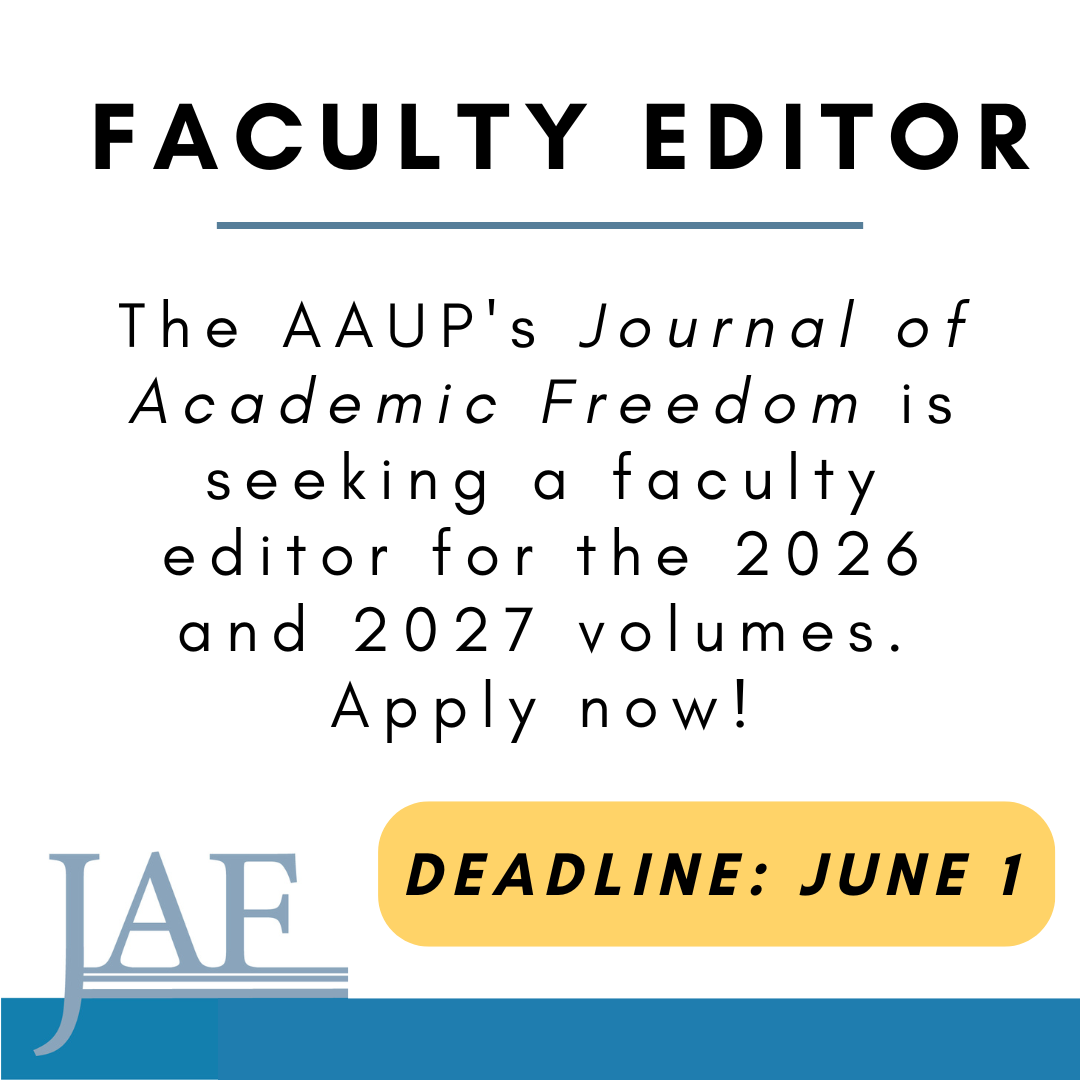- About
- Programs
- Issues
- Academic Freedom
- Political Attacks on Higher Education
- Resources on Collective Bargaining
- Shared Governance
- Campus Protests
- Faculty Compensation
- Racial Justice
- Diversity in Higher Ed
- Financial Crisis
- Privatization and OPMs
- Contingent Faculty Positions
- Tenure
- Workplace Issues
- Gender and Sexuality in Higher Ed
- Targeted Harassment
- Intellectual Property & Copyright
- Civility
- The Family and Medical Leave Act
- Pregnancy in the Academy
- Publications
- Data
- News
- Membership
- Chapters
State of the Profession: Protecting the Rights of Part-Time Faculty Members
“There should be no invidious distinctions between those who teach and/or conduct research in higher education, regardless of whether they hold full-time or part-time appointments or whether their appointments are tenured, tenure-track, or contingent. All faculty members should have access to the same due-process protections and procedures.”
These powerful sentences come from a new endnote to Regulation 13, “Part-Time Faculty Appointments,” in the AAUP’s Recommended Institutional Regulations on Academic Freedom and Tenure, published in the Bulletin issue of this magazine in August. The Recommended Institutional Regulations sets forth, in language suitable for use in faculty handbooks and collective bargaining agreements, rules that derive from the chief provisions and interpretations of the 1940 Statement of Principles on Academic Freedom and Tenure and the Statement on Procedural Standards in Faculty Dismissal Proceedings. Most of this language is of necessity legalistic and bland. Hence, the relegation of these potent words to a note should not be taken as diminishing their import. They were added by the AAUP’s Committee A on Academic Freedom and Tenure in June as part of a broader revision of the Recommended Institutional Regulations intended to clarify the Association’s current policy on the rights of faculty members on part-time appointments.
Previously, Regulation 13 consisted of a lengthy and complicated listing of rights to which faculty members on part-time appointments should be entitled. But most of the provisions were essentially no different from those applicable to full-time appointments. Separating them out led some to interpret the regulation as accommodating the second-class status of part-time faculty members. The revised document now makes clear that the majority of Regulations 1–10, 12, and 16 apply equally to all faculty members. The remaining three provisions in Regulation 13 serve only to strengthen the recommended reappointment rights of those hired on a part-time basis.
The changes are the product of lengthy discussions in Committee A of proposals for “part-time tenure.” Although we found that concept difficult to mandate, it must be stressed that just as AAUP policy has long considered any faculty member employed full time for more than seven years as, in effect, tenured, regardless of institutional policy, so too Regulation 13 provides protections approaching tenure for any part-time faculty member who has taught at least twelve courses or six terms in seven years. If such faculty members are reappointed, Regulation 13 states, they shall either be granted part-time tenure, where this exists, “with the same procedural safeguards as full-time tenured faculty,” or “shall have continuing appointments and shall not be replaced by part-time appointees with less service who are assigned substantially identical responsibilities without having been afforded the procedural safeguards associated with dismissal.”
The principle is simple. As the AAUP put it in launching our One Faculty campaign, “all faculty on part-time appointments, after a number of appropriate successive reviews for reappointments, should have assurance of continuing employment.”
As of 2017, some 40 percent of 1.6 million postsecondary teaching positions were part time, with only a handful of them tenured. When colleagues in those positions can be dismissed or not reappointed at will, the security and academic freedom of the entire profession will be severely endangered. That is why the AAUP seeks ways to protect the rights of all faculty members, and not just those within the dangerously diminishing reach of the tenure system. Last year the AAUP censured the administration of the Community College of Aurora in Colorado after administrators there summarily dismissed part-time philosophy instructor Nathaniel Bork, who had complained about administratively mandated curricular changes.
The rights of all faculty members—part-time or full-time, tenure-track or contingent—are best protected when we unite and organize in solidarity across ranks. When the AAUP was founded a little more than a century ago, very few faculty members enjoyed the protections of tenure. The situation was only marginally better when the AAUP and the Association of American Colleges issued the 1940 Statement. But our predecessors were able to change things, and we can too—if we work together. Where we can’t yet guarantee tenure, we can move terms of faculty appointments closer to tenure by establishing longer periods of appointment, increased opportunities for advancement, greater due-process protections, recognition of seniority, and conscientious peer evaluation.
This revision of the Recommended Institutional Regulations is intended to facilitate such efforts.
Henry Reichman is chair of Committee A on Academic Freedom and Tenure. His book The Future of Academic Freedom will be published next year by Johns Hopkins University Press.




